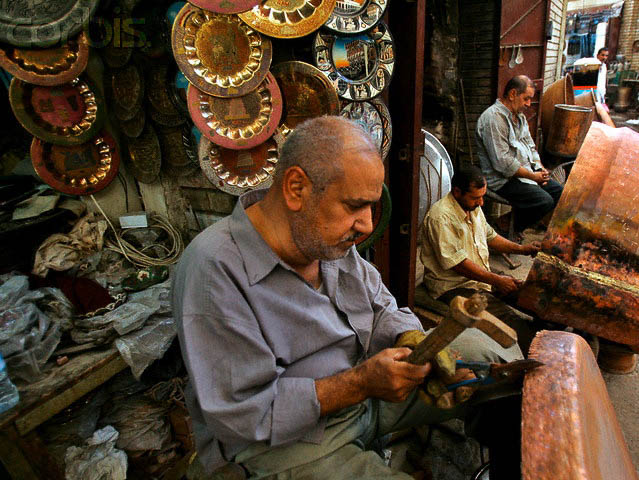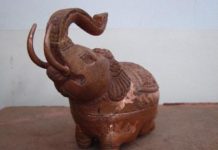The Iraqi term for the coppersmith is safar, and the plural is safafeer. It is one of Iraqi’s oldest handcrafts, with archaeological evidence that links this craft with the ancient civilisation of Mesopotamia. Also, this craft flourished during the Islamic Abbasid Caliphate in Iraq (750–1258), and developed as form, function, and production techniques, which can be seen in heavily ornamented objects for household items and many other applications. However, the Iraqi traditional safar practices his skills to produce either one of the following.
The safar produces cooking utensils and household items. These products draw from traditional designs, and function mainly for cooking. They include a variety of sizes of pots, trays, and other specialised utensils. Many of these products were traditionally used in Iraqi kitchens, then gradually disappeared from the 1970s. Also, many Iraqis are nostalgic about specific copper utensils, such as the traditional Arabic coffee pots, which they collect and present as decorative items in their houses. These products are seen as a signifier for authenticity, family heritage, and traditional hospitality practices. Much cooking ware is produced from sheets of copper with 0.7mm thickness and up. These sheets are then shaped through hammering, and other basic techniques, and then a tin lining is applied to coat the interiors of the final product, to enhance its usability for cooking, as well as to protect the copper from corrosion.
The other main category of production is cultural and decorative designed products. Many fine copper pieces use designs based on interpretations of ancient themes and recreated images of icons from ancient Iraqi civilisations, as well as borrowing symbols and images from Islamic icons such as mosques, shrines, compositions of Arabic calligraphy and ornamental illustrations from the Quran or poetry. Specialist, fine skilled safars utilise traditional techniques and tools to produce these items from brass, a yellow copper alloy, that is also known as “poor man’s gold”, which comes in sheets with a variety of thicknesses. These products are used and sold mainly as interior decorative items and souvenirs that target both the local customers and the tourists.
Souk al-Safafeer was the Iraqi coppersmith’s market. Known as one of central Baghdad’s oldest streets, Souk al-Safafeer is a 500 metre long avenue, linking al-Mustansiriya – the well-known Abbasid Caliphate school, built on the banks of Tigris – and the commercial heart of Baghdad, in al-Rasheed street. Souk al-Safafeer enjoyed a bustling and productive time after the restoration of its buildings in the late 1970s, when it flourished and became known as an important heritage location. The unique experience of Souk al-Safafeer was associated with the process of making the copper products. While shopping in Souk al-Safafeer, people could enjoy hearing the variety of sounds and noises which resulted from hammering the copper sheets to produce a variety of applications by each safar. Tourists and shoppers could also enjoy watching the skilled safars practising the techniques of modifying the copper and brass sheets through hammering, stretching, shrinking, raising, repousse, chiselling and chasing.
These ancient techniques were enhanced by the heating treatment known as annealing, which strengthens the copper’s physical properties, and softens the hammering effects, to create a better finish and advanced form and ornamenting details. The techniques for making cultural and souvenir items relied on al-Safar’s fine hand skills in cutting the sheets according to design templates, then modifying the form using a variety of hammers and anvils. The final product may require the joining of more than one piece through soldering to create the final 3D composition. Then, a process of surface treatment is used to enrich the product’s look and values. This process involves the fine cutting of designed patterns, modifying edges, and using special chisels to emboss or engrave a variety of organic or geometric compositions, often inspired by Islamic calligraphy and ornaments. Most of the shops in the Souk al-Safafeer showed ready-made items for sale, and at the same time, allowed customers to order custom designs.
Souk al-Safafeer is silent now, as a result of the slow death of this important craft sector. In fact, this silence is a reflection on the country’s chaos since the 1990s. The traditional process of craftsmanship pashas not been passed on to the new generation, and the Safareen craft is lost. Many news reports have addressed this unhappy reality and led to debates about the reasons. In fact, the Souk al-Safafeer shops and workshops are now transformed from making and selling copper and brass product into selling imported readymade cheap products and textiles! Copper products are increasingly made in India and imported through Dubai. Coppersmithing still exists in Iraq but it is diminishing.
Further reading
- Omar, O. (2016) Souk al-Safafeer, a fading Baghdad landmark. In The Arab Weekly, Issue 40, P. 12. http://www.thearabweekly.com/Special-Focus/3447/Souk-al-Safafeer,-a-fading-Baghdad-landmark (retrieved Jan/2017)
- Melek, N. (2009) The Silence of the Souqs. In Axis of Logic. http://axisoflogic.com/artman/publish/Article_56260.shtml (retrieved Jan/2017)
- Jones, G. (2014) Coppersmith: Reviving the ancient craft of copper-working, interview with Michael Johnson, Founder of The Copper Works, Newlyn. In Merchant & Makers, Celebrating craft, design & heritage. http://www.merchantandmakers.com/cornish-coppersmithing-the-copper-works-newlyn/ (retrieved Feb./2017)
Visual references




